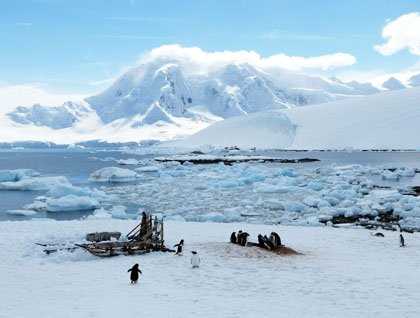We have reached the west side of the Antarctic Peninsula. Here, westerly winds bring relatively moist air from the Bellinghausen Sea. As the air is deflected upward, it cools and drops its moisture as snow, making this the snowy side of the Peninsula. The scenery is simply spectacular. Everywhere, glaciers descend the steep slopes to drop their load of ice into the sea. These are not the large, flat-topped tabular icebergs, but irregular pieces of myriad sizes and shapes. They range in color from white to blue. We spent our day in such an environment, delighting at the scene that surrounded us.
Our first stop was at Orne Harbour for a landing on the Antarctic Continent. By traversing a steep, snowy slope, the hikers reached a ridge where chinstrap penguins sent out their raucous calls. They are the mountain climbers of the Antarctic penguins. We only had to do the climb once, up and down. The little chinnies do it over and over, up and down, up and down, in the course of each breeding season, as they bring food to their ever-more-hungry young. The climb was only an option; others viewed the scene from water level on Zodiac cruises. We encountered breeding kelp gulls, Antarctic terns, and Antarctic shags (with their beaks full of seaweed to add to their nests and impress their mates).
We passed through the Neumayer Channel, one of the most impressive passages in Antarctica, to reach Port Lockroy. This protected natural harbor was found by the French explorer Jean Baptiste Charcot in 1904, and used by whalers in the early decades of the 20th century. The bones of their prey remain. In 1944, the British established a base here. Its function in the war effort is not at all clear. After the war, it became a site for geographical and atmospheric research by the Falkland Islands Dependency Survey (later the British Antarctic Survey). The sleds that now sit on the snow in front of the main building were once pulled over the Antarctic snow by dogs on survey trips that could last for months. The station was abandoned in the 1960s. It fell into ruin until the British Antarctic Heritage Trust restored it as an Antarctic museum and the southernmost gift shop of our voyage, of which we took full advantage. Gentoo penguins nest under and around the buildings, and at nearby Jougla Point, paying little attention to our visit.
We departed Port Lockroy and headed further south. We encountered a field of broken sea ice, and National Geographic Explorer demonstrated her ice capability by slicing neatly through. After dinner, we passed through the justifiably famous LeMaire Channel, a narrow waterway between Booth Island and the Antarctic Peninsula. Steep snow and ice-covered slopes rose on either side of the ship. Clouds and fog provided a sense of mystery, even if they did obscure the lovely Una from our admiring gaze.
This was the southernmost point of our voyage. We passed back through the LeMaire Channel in fading light and headed toward tomorrow's adventures.







